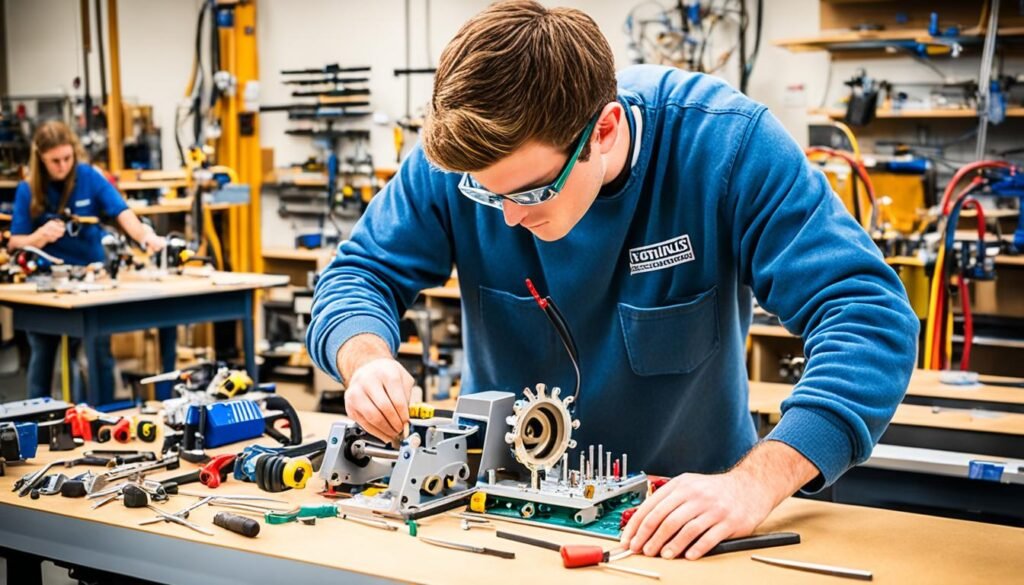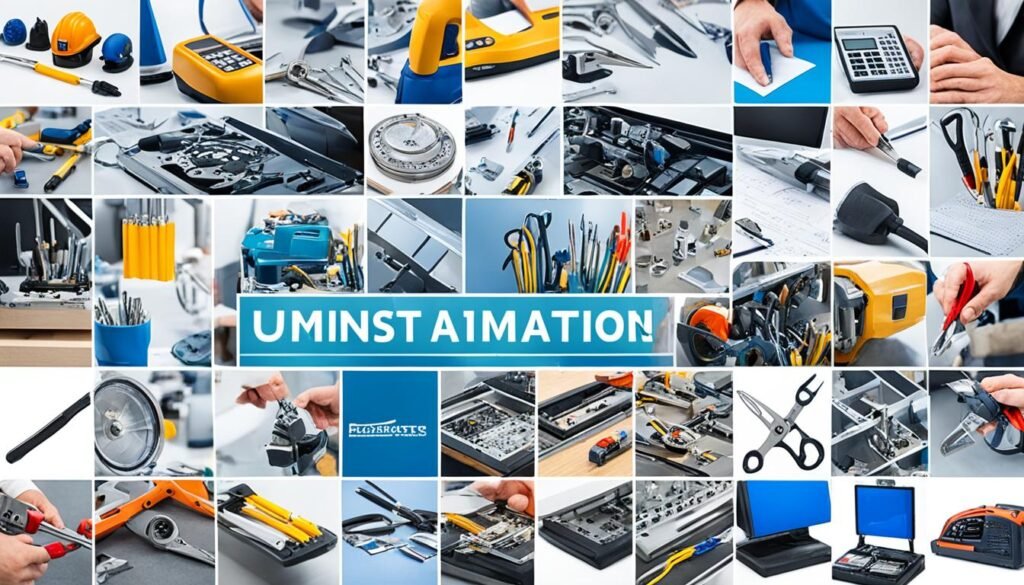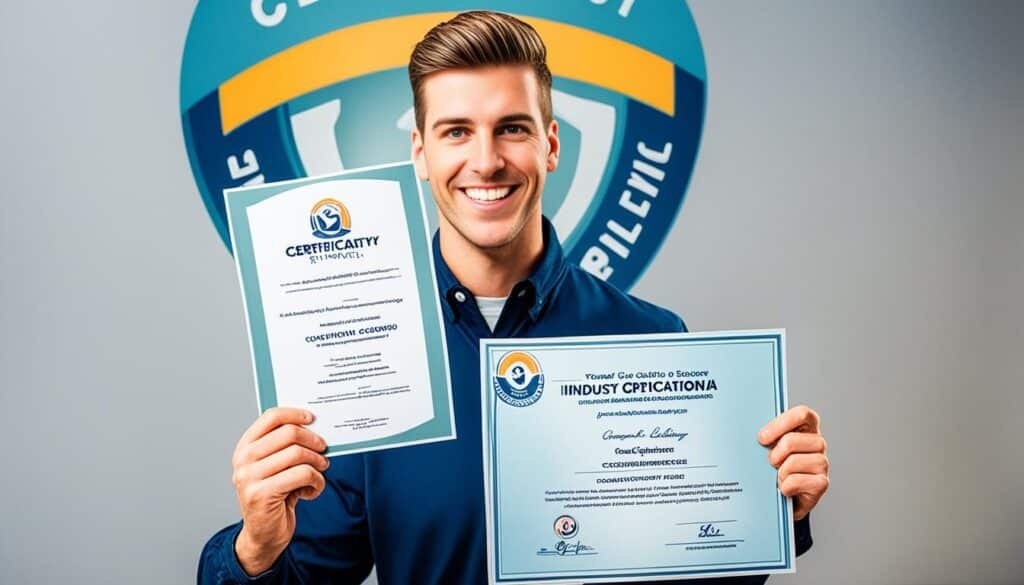In the United States, career and technical education (CTE) is key to preparing students for their future careers. It offers a mix of traditional learning and hands-on experiences. This helps students gain the technical and professional skills needed in the job market.
While traditional education focuses on theory, CTE gets students ready for work. It shows students the skills they’ll need for popular jobs. Students get to work in real job settings through internships and apprenticeships. This gives them a taste of what’s to come in their careers.
CTE’s main goal is to help students succeed in the workforce and improve their lives. By keeping up with what industries need, CTE programs teach students the skills for good jobs. This not only helps students but also boosts the strength of the overall workforce.
The job market is always changing because of new technology and industries. CTE helps students understand and succeed in this changing world. It combines solid education with real-world training. This way, students are ready for the future they’ll face at work.
Key Takeaways
- CTE programs provide a blend of academic learning and hands-on, practical experiences to develop students’ technical, employability, and academic skills.
- CTE focuses on preparing students for in-demand careers and career pathways, aligning curriculum with the evolving needs of industries.
- Through industry partnerships, CTE students gain exposure to real-world work environments, apprenticeships, and internship opportunities.
- CTE contributes to workforce development and economic mobility by equipping students with the skills and credentials required for success in their chosen field.
- As the job market continues to evolve, CTE stands as a critical educational model that prepares students to navigate the complexities of the modern workforce.
Career and Technical Education: An Overview
Career and technical education (CTE) is becoming more popular in the United States. It’s a modern form of the old vocational education, but with a new goal. This new goal is to help students get the skills, knowledge, and training needed for good jobs.
CTE mixes traditional lessons with real-world learning. This way, students can learn both academic and practical skills. These skills are important for jobs that are in high demand and pay well.
What is Career and Technical Education (CTE)?
CTE combines tough classroom lessons with skills that are needed in real jobs. It isn’t like only learning from books. In CTE, students learn by doing real things, like creating projects or working with tools.
They learn how their classroom lessons apply to real jobs. This makes it easier for them to understand what they are studying.
Importance of CTE in Preparing Students for the Workforce
CTE is very important for getting students ready for jobs. It helps them learn the technical skills and how to be ready for careers. With the help of CTE, students can find good jobs that they like.
CTE also helps by giving students chances to earn certificates and work in real jobs. This can give them a head start in finding and doing well in their chosen careers.
Hands-On Skill Development

At the core of Career and Technical Education (CTE) is a big focus on hands-on skill development. Unlike regular academic classes, CTE helps students get practical, technical skills. These skills come in handy in their future jobs. CTE students learn by doing, not just by reading.
Acquiring Technical Skills
CTE teaches students a variety of technical skills. They learn to use tools, measure precisely, and handle materials. By getting lots of hands-on practice, they become good at what they do. This prepares them well for jobs, further training, or vocational pathways.
Building Employability and Soft Skills
CTE isn’t just about technical skills. It also helps students with employability and soft skills needed at work. They learn problem-solving, teamwork, and communication skills. These professional skills make CTE students attractive to employers.
Career Exploration and Pathways

Career and technical education (CTE) provides a unique chance for students to look into real career opportunities. Most academic courses don’t deeply cover how what’s learned in class connects to career pathways. CTE changes this by offering practical hands-on experiences to help students see the job they’re aiming for.
These programs immerse students in industry-specific training and work-based learning experiences. Students get to understand the job skills, technical skills, and professional skills needed for their future success. This real-world career exploration guides students in making well-informed decisions about their future career pathways.
Exposure to Real Career Opportunities
CTE programs team up with local employers and industry experts. Together, they provide students with chances to join internships, apprenticeships, and other work-based learning opportunities. These experiences help students use their technical skills in real settings. They also give a peek into the daily duties and hurdles in their potential career pathway.
Alignment with Industry Demands
Not only do CTE programs expose students to practical career opportunities, but they also keep their training and lessons in sync with what the industry currently needs. With the help of local employers and industry partners, these programs can adjust their courses. This ensures students learn skills that are in demand in the regional economy, preparing them for future careers successfully.
Industry Partnerships and Relevance
It’s vital for Career and Technical Education (CTE) programs to stay up-to-date and relevant. They help students get ready for great jobs. CTE teachers work closely with employers and industry experts. They design the study plans, add new tech, and make sure students get to practice what they’ve learned.
Collaborating with Employers and Industry Experts
CTE programs join hands with local businesses and industry associations. They also work with other important groups. This way, they keep their programs fresh and in line with what jobs need. By working together like this, educators find out what skills and tech are most important. Then, they focus on teaching these in their classes.
Ensuring Curriculum Relevance
CTE programs listen to what the industry says. By doing this, they make study plans, set up lessons, and activities fit the real job world. This approach means students get to learn what they really need to land great jobs.
AIR, an expert in CTE, helps these programs. They make sure CTE courses meet today’s job market needs. This group teams up with local schools and the government. Their goal is to improve CTE policies and programs. This work is key to helping students be ready for their careers and move up economically.
Career And Technical Education

In the world of career and technical education (CTE), students can dive into a variety of programs. These programs cover many industries, from building and healthcare to tech and making things. Students get the chance to learn with their hands and pick up skills needed for jobs that are in demand. This way, they can get ready for their future careers.
CTE Programs and Concentrations
CTE programs have a goal: to give students the right technical skills and knowledge for well-paying, needed jobs. There are loads of career choices, such as in farming, design, and business. Each student can find a CTE path that matches what they like and dream about.
Dual Enrollment and Articulation Agreements
Many CTE programs offer ways for high school students to get a head start on college. Through dual enrollment, students can take CTE courses that count for college credit. This gives them a boost when they start higher education. Articulation agreements also make it easier for CTE students to move from high school to college. Their CTE credits can transfer, and their skills get recognized.
| CTE Program | Industry Concentration | Potential Career Pathways |
|---|---|---|
| Construction Technology | Construction Trades | Carpenter, Electrician, Plumber, HVAC Technician |
| Health Sciences | Healthcare | Registered Nurse, Medical Assistant, Pharmacy Technician |
| Information Technology | Computer Science and Technology | Software Developer, Network Administrator, Cybersecurity Specialist |
| Manufacturing Technology | Advanced Manufacturing | Machinist, Welder, Robotics Technician, Quality Control Inspector |
Certifications and Credentials

Career and Technical Education (CTE) gives students a chance to earn industry-recognized certifications and credentials. These show the technical skills students learned. They give students a big competitive edge when looking for jobs.
Industry-Recognized Certifications
CTE programs work closely with local employers and industry experts. This ensures certifications are important in the work world. They focus on current industry needs, so students get marketable skills and professional credentials that employers want.
Stackable Credentials and Career Pathways
Some CTE programs offer stackable credentials. Students can add to their certifications as they move forward. It’s a flexible way of learning. Students can learn at their own speed, improving their employability and job prospects.
Improving Graduation Rates

Career and Technical Education (CTE) really helps students finish high school. When students get deeply involved in a CTE area, they are 7% more likely to graduate on time. CTE students show a 94% graduation rate, which is much higher than the national average.
Engaging and Relevant Learning
CTE is all about hands-on learning. This approach makes learning fun and practical for students. They get to see how their schoolwork connects to future jobs, boosting their motivation to learn.
CTE classes teach skills needed in different careers. This makes school more interesting and helps students stay focused on their graduation goals.
Preparing for Postsecondary Transitions
CTE isn’t just about high school. It also helps students get ready for what’s next. For students, this means they can earn college credit and industry certifications early. This way, when they graduate, they’re already a step ahead in job and education opportunities.
Equity and Access in CTE
CTE is always changing, making it key to make sure all students can join in. No matter background or money, everyone should get a fair shot. The American Institutes for Research (AIR) works to include all students in CTE through research and help.
Closing Achievement Gaps
AIR teams up with Ohio’s Education Department to better teach about fairness in CTE. They hold special training for state folks and district fairness leaders to learn how to promote equality. The focus is on making sure CTE is fair for everyone, pinpointing and fixing any unfair gaps, and making learning spaces that welcome all.
Promoting Diversity and Inclusion
AIR also works hard to add more variety and welcome in CTE. They link with schools and companies to make learning friendlier and open up chances to try jobs. They make sure what students learn celebrates different cultural views and stories. This makes CTE more welcoming and prepares a diverse, skilled workforce for tomorrows jobs.
Making CTE fair and open helps everyone succeed. So by breaking down big problems and finding ways for all to do well, CTE really can help the next career whiz get ready. It can make our future job worlds more fair and rich for everyone.
Also Read: University Scholarships For USA Students
CTE and the Future of Work
Technology is changing the way we work. Career and Technical Education (CTE) programs are also changing. They’re making sure students are ready for the new job market. CTE teaches skills that will be important in jobs of the future, like knowing about automation and artificial intelligence.
Emerging Technologies and Automation
CTE keeps up with new technology. It gives students real-world experience in areas like robots, coding, and making things on computers. This knowledge gives CTE students an advantage in jobs that are changing because of technology.
Developing Future-Ready Skills
CTE focuses not only on tech skills but also on “future-ready” skills. These include thinking critically, solving problems, and being able to adapt. These skills help students succeed in many fields, from hands-on jobs to more professional roles. CTE teaches skills that will always be valuable, making students ready for jobs that might not even exist yet.
Work is always changing, but CTE prepares students for what’s ahead. They do this by working closely with businesses, providing real experiences, and focusing on skills that are always in demand. This way, CTE is creating a group of workers who will innovate and help the economy grow.
FAQs
What is Career and Technical Education (CTE)?
CTE is a model found in many U.S. schools. It’s the next step from old vocational education. This model readies students for their future jobs by teaching necessary skills and knowledge.
How does CTE prepare students for future careers?
CTE mixes classroom lessons with real-world experiences. This helps students learn important technical and job skills for well-paying careers. They learn by doing, gaining hands-on experience.
What are the key benefits of CTE?
CTE lets students try real career paths and earn valid certifications. It boosts high school graduation rates, with CTE students being 7% more likely to graduate on time.
How do CTE programs collaborate with industry partners?
CTE works closely with employers to ensure its teachings match what’s needed in the workforce. This connection between schools and real jobs helps students know how to start their careers.
What types of CTE programs and concentrations are available?
CTE offers a variety of paths like construction, healthcare, and IT. Students gain direct experience and learn skills specific to different fields.
How do CTE programs help students earn industry-recognized credentials and certifications?
Through CTE, students can get certifications that prove their skills. This makes them more competitive when they look for jobs.
How does CTE impact high school graduation rates?
CTE students have a 94% rate of finishing high school. They find CTE engaging and valuable for their future, helping them succeed after high school.
How is CTE addressing equity and access?
Groups like AIR improve CTE by using the latest research. They make sure CTE is equal and open for all. This includes teaching fairness in the job market.
How is CTE adapting to the future of work?
CTE is changing to prepare students for a future with new tech and jobs. It focuses on skills like thinking critically and solving problems. These skills will help students succeed in any job.




